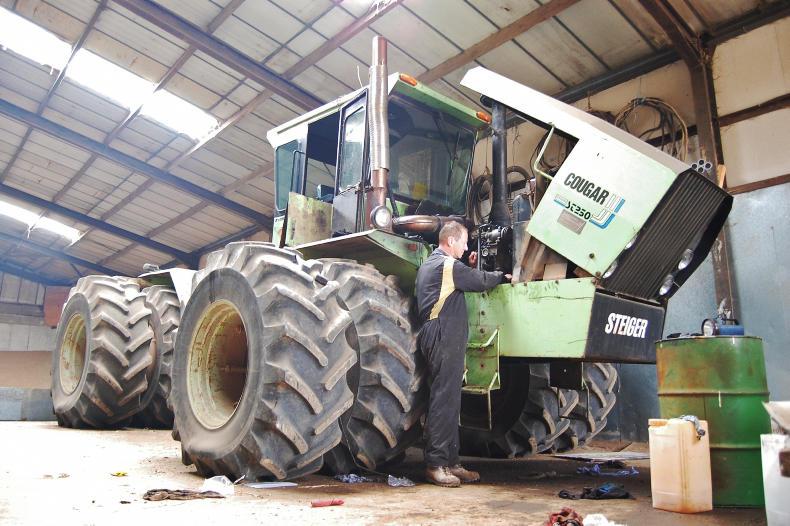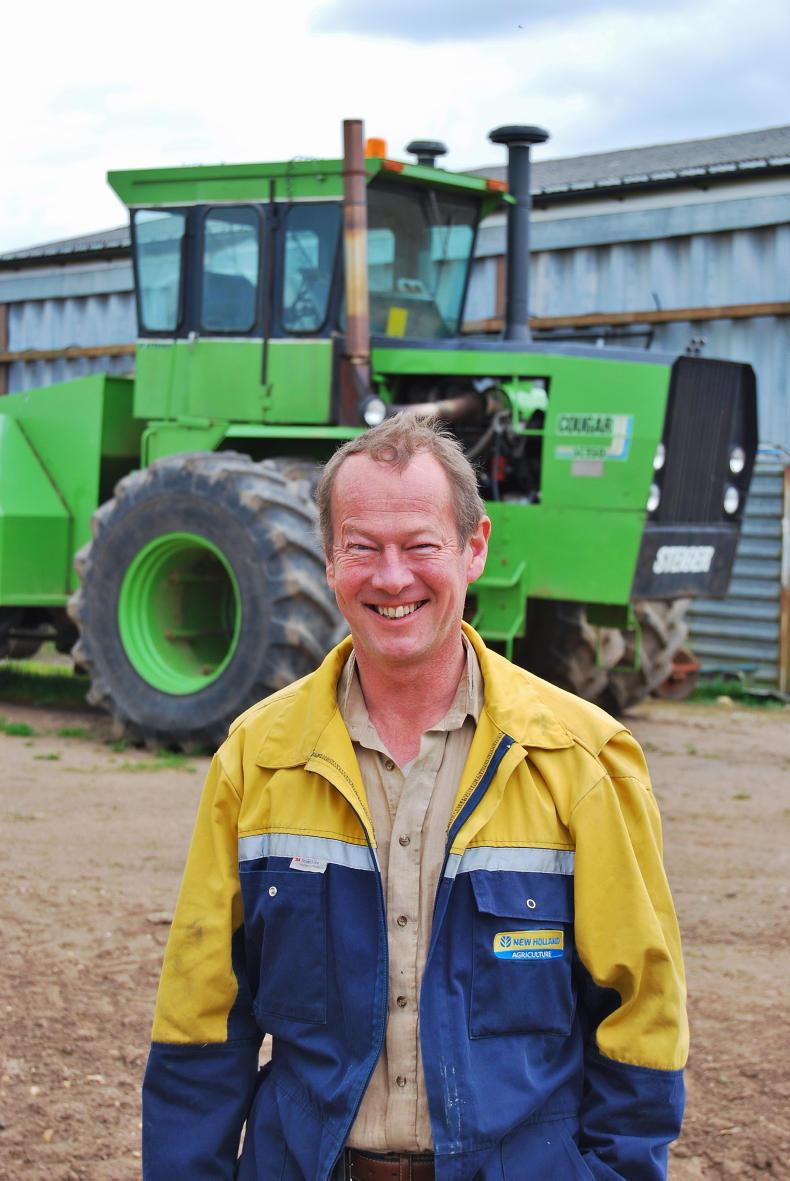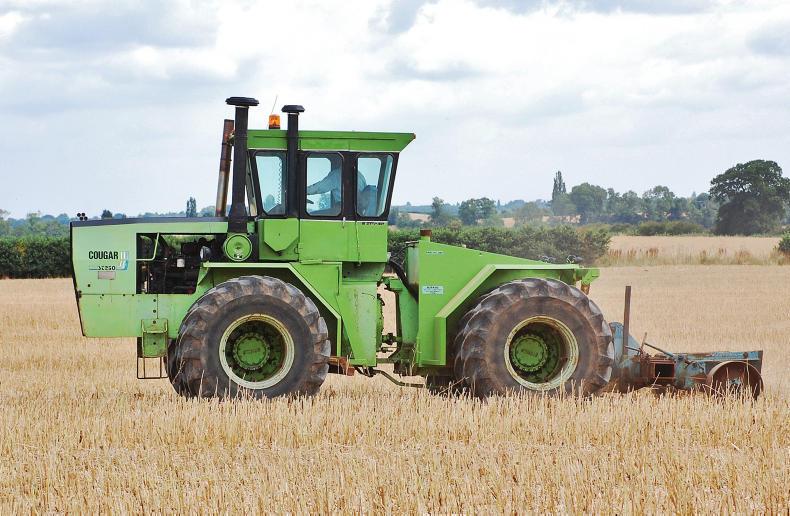The articulated tractor is a common sight on tillage farms around the globe, having become an almost indispensable tool for the world’s arable growers, with machines like the Case-IH STX Quadtrac, built at the CNH-owned Steiger tractor plant in North Dakota, becoming the archetypal bend-in-the-middle acre-eater.
The story of the first Steiger imported into Britain, starts in 1976. This was at a time when 100hp was still considered to be unnecessary for general farm use, and British conversion specialists such as County and Muir Hill dominated the heavyweight four-wheel drive sector.
Booming grain market
Booming grain markets throughout the 1970s led to a trend for scrubbing out hedges to make larger fields. These fields required larger equipment to till them. The result was that an increasing number of UK farmers in central and eastern England started looking across the Atlantic towards the American midwest, where big horsepower was a necessity for farming.

In the spring of 1976, brothers Fred and Les Moreton, who farmed near Leamington Spa in Warwickshire, placed an order for a brand new Steiger Cougar ST250 III. Having spent several months negotiating the import of this tractor into the UK, their interest had caught the attention of the top brass at Steiger in North Dakota, who began to realise the potential of this new niche market in Britain. But they had no UK dealer.
Keen to establish a presence there, Steiger approached the Moreton family with the offer of becoming its sole UK agent. The brothers agreed, but decided that the new business venture should be separate from their farming enterprise. The result was the establishment of Offchurch Tractors, a name that was quickly to become synonymous with articulated tractors throughout Britain.
The Moreton’s tractor was scheduled for delivery in June 1976. This would become the primary cultivation tractor on the family farm, and would be used as a demo tractor, making its public debut in July 1976, at the Royal Show in Stoneleigh.

Still in service after 41 years, OVC 579P clocks around 150 hours a year, mainly performing heavy cultivation work.
The tractor, which had arrived from America only days before, was powered by a CAT 3306 engine, driving 24.5 x 32in dual-wheels front and rear, mounted on (Hungarian) Rabe axles. It was also equipped with double-acting rear linkage and a state-of-the-art air-conditioned cab.
During its time with Offchurch Tractors, the Steiger was used for an organised demonstration tour, which took place in the spring of 1977. Starting at Alnwick in the Scottish Borders, it worked down the eastern side of England, ending in Kent.
In total, 10 different locations were used to demonstrate the lime-green tractor, which was displayed with a bespoke-built 10-furrow plough, designed for the tractor by the late Roger Dowdeswell, the founder of Dowdeswell Ploughs.
In 1979, the Cougar was sold to the Moreton’s farming neighbours, Richard and Norman Reeve, who bought it to replace two Muir Hill 121 tractors. The Steiger would remain an integral part of the family’s fleet for the next 25 years, before being eventually adopted by Richard’s son Jim, when his father and uncle retired from active farming.
I checked the fluids, fitted a fresh battery and it fired straight up. I ended up drilling 100ha of OSR and about 80ha of stubble turnips with it, before we managed to get a hire tractor to replace the 7930
Today Jim Reeve, who now runs an entirely tillage operation totalling 560ha, still uses the Steiger, adding about 150 hours to the clock each season, mainly performing deep-cultivation work, including sub-soiling/chisel-ploughing the farms heavy ground.
“The Steiger completely saved us last year,” reports Jim. “We were using our John Deere 7930 for drilling OSR, when the transmission failed. The Steiger was parked up at the time. I checked the fluids, fitted a fresh battery and it fired straight up. I ended up drilling 100ha of OSR and about 80ha of stubble turnips with it, before we managed to get a hire tractor to replace the 7930.”

Regular maintenance has been the key to keeping this Steiger Cougar in working condition. To date, it has clocked 10,000 hours on its original CAT 3306 engine.
This may be Britain’s oldest Steiger, but it’s far from being decrepit. The Reeve family have kept the tractor in very good condition, and not only does the tractor still look good cosmetically, it still has its original six-cylinder, turbo-charged Cat engine.
Naturally, there have been a few mechanical problems over the years, such as turbo-charger failure, a couple of blown head-gaskets, and the occasional electrical issue. Yet for the most part, the Steiger, which has clocked 10,000 hours, has been a pillar of reliability.
“Last year we gave it a fresh coat of paint,” reveals Jim. “This year, we’ve just changed the water pump. It’s also had a new tyre this time. You have to keep on top of the maintenance with this type of tractor.”
Even by modern standards, the Steiger Cougar remains a big tractor. Standing more than 3.4m high and 6.4m in length, it weighs-in at more than 14t when fully ballasted, and boasts a 110l/min hydraulic pump, providing enough lift capacity for its Cat III rear linkage to handle more than 5t. In 1976, these were impressive statistics.
For those who have never driven one of these pivot-steer dinosaurs, operating the Cougar can be quite a challenge. The cab is spartan, but suprisingly comfortable, with a supportive Bostrom seat and a fully adjustable steering wheel. The controls are rudimentary, with a neat collection of simple dash-mounted gauges providing the necessary information to avoid a mechanical disaster.
With the exception of the main gear lever, which lies at the driver’s feet between the clutch and brake pedal, most of the major controls are to the right of the seat.

Warwickshire farmer Jim Reeve, pictured with the Steiger Cougar ST250 III, which his family have owned since 1979.
To confuse the uninitiated, the foot throttle, next to the brake, is actually a decelerator used to assist turning on the headlands.
Information decals stuck on the dashboard and front window indicate the layout of the major controls, in addition to describing the complicated starting procedure, which requires the use of both hands and feet simultaneously. A degree of pre-heating is required to bring the 10.5l Caterpillar engine to life, which celebrates its awakening with a bellow of thick black smoke.
I’ve considered selling it in the past, but what could I replace it with? It owes us absolutely nothing, and it’s always there if we’re ever in a fix
This is a 10-speed tractor, equipped with a five-speed/two-range gearbox and a hydraulically assisted heavy-duty dry clutch. The main working gears assigned by Steiger were third through to seventh. However, according to Jim Reeve, gears 4 and 5 serve well for most tasks. “We run the tyres at about 7psi on all eight wheels,” says Jim. “This reduces compaction and improves grip. Wheel slip is virtually non-existent in dry conditions, even under heavy load.
“You must have the tractor moving before you lower the implement into the ground,” he adds. “If you try and pull away with the tines in the ground, you will destroy the clutch. The trick is to have the engine running at almost full power before you lower the implement into the ground.
“If you stall the engine, you risk seizing the turbo. If you don’t allow enough room on the headlands, you risk ripping out the hedge with the implement behind you,” he concludes. “I’ve considered selling it in the past, but what could I replace it with? It owes us absolutely nothing, and it’s always there if we’re ever in a fix.”
At a glance, Jim Reeve’s Steiger Cougar ST250 III, looks no different to any other Steiger. Yet this really is the actual tractor which visitors to the 1976 Royal Show, would have seen for the very first time. Who would have imagined then, it would still be working 41 years later?






 This is a subscriber-only article
This is a subscriber-only article










SHARING OPTIONS: